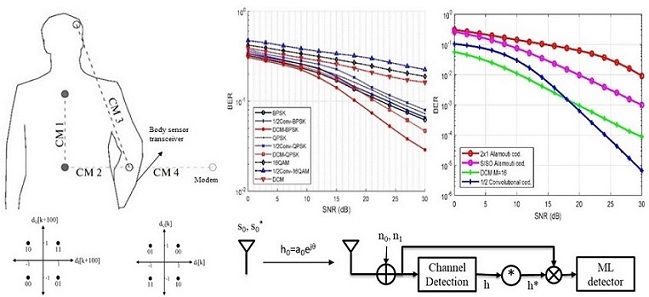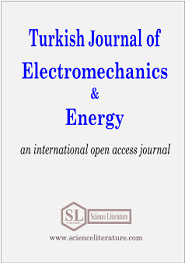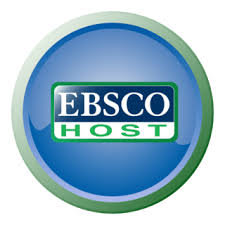
Comparative analysis of dual carrier modulations with channel coding and space-time coding
Abstract
Dual carrier modulation (DCM) is a type of modulation proposed for use at high data rates. DCM was created to make successful communication by making transmitter diversity. In this modulation, the same information is modulated with two different constellation diagrams, forming a kind of 1/2 code rate versus raw modulation. In space-time coding, performance improvement is made by utilizing multiple antenna diversity. This paper presents a comprehensive comparative analysis of DCM with channel coding and space-time coding techniques in the context of wireless body area networks (WBANs). The performance of DCM is evaluated against 1/2 convolution channel coding, 16 quadrature amplitude modulation (16QAM), quadrature phase shift keying (QPSK), and binary phase shift keying (BPSK) modulations. Additionally, the single input single output (SISO) adaptation of Alamouti space-time block coding (STBC) is considered for comparison with DCM. Extensive simulations are conducted on various channel models, including the additive white Gaussian noise (AWGN), Proakis A, B, C, and WBAN channel model 4 (CM4) channels. The results demonstrate that DCM outperforms convolution channel coding and STBC, particularly at high modulation.
Full Text:
PDFReferences
S. M. Alamouti, “A simple transmit diversity technique for wireless communications,” IEEE Journal on Selected Areas in Communications, 16(8), pp. 1451-1458, 1998.
A. Batra and J. Balakrishnan, “Improvements to the multi-band OFDM physical layer,” in Proceedings of the 3rd IEEE Consumer Communications and Networking Conference, 08-10 Jan. 2006, Las Vegas, USA [Online]. Available: IEEE Xplore, http://www.ieee.org. [Accessed:16.06.2018].
Ecma International, Ecma-368 high rate ultra-wideband PHY and MAC standard, IEEE Std, Geneva, 2008.
K. H. Park, H. K. Sung and Y. C. Ko, “BER analysis of dual carrier modulation based on ML decoding,” in Proceedings of the Asia-Pacific Conference on Communications, 31 Aug. 2006, Busan, South Korea [Online]. Available: IEEE Xplore, http://www.ieee.org. [Accessed:21.06.2018].
T. Wu and T. Chen, “Dual carrier modulation in channel aggregation for 60GHz WLAN system,” IEEE Wireless Communications Letters, 7(5), pp. 792-795, 2018.
S. K. Kondoju, V. V. Mani and R. Bose, “Exact BER analysis of DCM for multiband OFDM-UWB system over uncorrelated Nakagami-M fading channels,” in Proceedings of the IEEE International Conference on Ultra-WideBand (ICUWB), 01-03 Sept. 2014, Paris, France [Online]. Available: IEEE Xplore, http://www.ieee.org. [Accessed:16.06.2019].
S. K. Kondoju and V. V. Mani, “Outage and BER analysis of dual-carrier modulation over frequency-selective Nakagami-m fading channels,” International Journal for Computation and Mathematics in Electrical and Electronic Engineering, 36(1), pp. 90-107, 2017.
Y. Feng, B. Zhang, C. Zhi, K. Liu, W. Liu, F. Shen, C. Qiao, J. Zhang, Y. Fan and X. Yang, “A 20.8-Gbps dual-carrier wireless communication link in 220-GHz band,” China Communications, 18(5), pp. 210-220, 2021.
A. R. Ferdous, “Bit error rate performance evaluation of an ultra-wideband communication system with dual carrier modulation and space diversity,” MS Thesis, Bangladesh University of Engineering and Technology, Dhaka, 2019.
Y. Qian, L. Xiao and T. Jiang, “SM-STBC aided orthogonal time frequency space modulation,” in IEEE Wireless Communications and Networking Conference (WCNC), 10-13 April 2022, Austin, TX, USA [Online]. Available: IEEE Xplore, http://www.ieee.org. [Accessed: 07 May 2021].
U. I. Hamouda, M. J. Bendaw, T. M. Buzid and M. M. Eddaghel, “Comparison of BER performance of SISO, MISO and MIMO systems based on OSTBC and EO-STBC techniques,” in Third Conference for Engineering Sciences and Technology (CEST- 2020), 1-3 Dec. 2020, Alkhoms, Libya.
Y. Karan and S. Kahveci, “QPSK-dual carrier modulation for ultra-wideband communication in body area network channels,” Turkish Journal of Electrical Engineering & Computer Sciences, 27(4), pp. 2526-2540, 2019.
IEEE Standards Association, IEEE Standard for Local and Metropolitan Area Networks - Part 15.6: Wireless Body Area Networks. IEEE Std, New York, 2012.
Y. Karan and S. Kahveci, “Performance comparison of wireless body area network protocol with dual carrier modulations,” Journal of Communications Technology and Electronics, 68(5), pp. 527–539, 2023.
R. Yang and R. S. Sherratt, Novel Applications of the UWB Technologies, (Chapter:1) Multiband OFDM Modulation and Demodulation for Ultra Wideband Communications, First Edition, IntechOpen, Rijeka, 2011.
J. Meyer, “Convolution decoder using the viterbi algorithm,” U.S. Patent and Trademark Office. U.S. Patent No 5,802,115, Washington DC, 1998.
F. Huang, “Evaluation of soft output decoding for turbo codes,” Master Thesis, Virginia Polytechnic Institute and State University, Virginia, 1997
J. Jootar, J. R. Zeidler and J. G. Proakis, “Performance of Alamouti space-time code in time-varying channels with noisy channel estimates,” in Proceedings of the IEEE Wireless Communications and Networking Conference, 13-17 March 2005, New Orleans, LA, USA, [Online]. Available: IEEE Xplore, http://www.ieee.org. [Accessed: 21 June 2019].
A. Çalhan, C. Çeken and İ. Ertürk, "A teaching demo application of convolutional coding techniques for wireless communications," in 2009 IEEE International Conference on Application of Information and Communication Technologies, 14-16 October 2009, Baku, Azerbaijan [Online]. Available: IEEE Xplore, http://www.ieee.org. [Accessed: 07 Sept. 2022].
K. Takizawa, T. Aoyagi, J. I. Takada, N. Katayama, K. Yekeh, Y. Takehiko and K. R. Kohno, “Channel models for wireless body area networks,” in Proceedings of the 30th Annual International Conference of the IEEE Engineering in Medicine and Biology Society, 20-25 Aug. 2008 Vancouver, BC, Canada [Online]. Available: IEEE Xplore, http://www.ieee.org. [Accessed: 13 Oct. 2019].
K. Sankar, “DSPLOG signal processing for communication,” [Online]. Available: http://www.dsplog.com/2008/10/16/alamouti-stbc/ [Accessed: April 23, 2021].
R. K. Roy and T. K. Roy, “BER analysis of MIMO-OFDM system using Alamouti STBC and MRC diversity scheme over Rayleigh multipath channel,” Global Journal of Research in Engineering, 13(13), pp. 14-24, 2013.
S. Nandi, A. Nandi and N. N. Pathak, “Performance analysis of Alamouti STBC MIMO OFDM for different transceiver system,” in Proceedings of the International Conference on Intelligent Sustainable Systems (ICISS), 07-08 Dec. 2017, Austin, Palladam, India [Online]. Available: IEEE Xplore, http://www.ieee.org. [Accessed: 07 May 2021].
R. Qomarrullah, I. W. Mustika and S. Dharmanto, “Performance comparison of SISO and MIMO-OFDM based on SDR platform,” in 3rd International Conference on Science and Technology-Computer (ICST), Yogyakarta, Indonesia, 2017.
URN: https://sloi.org/urn:sl:tjoee82290
Copyright (c) 2023 Turkish Journal of Electromechanics and Energy

This work is licensed under a Creative Commons Attribution-NonCommercial 4.0 International License.

 Indexed in:
Indexed in:
















